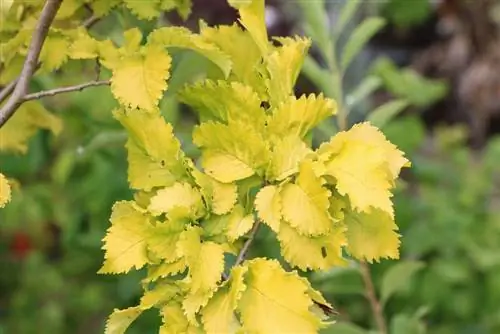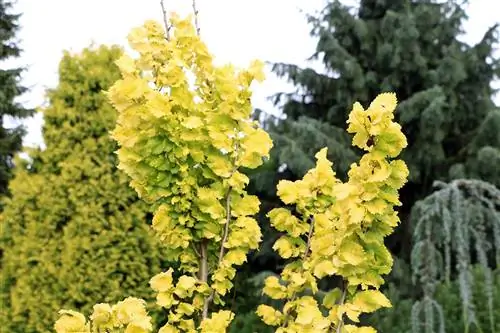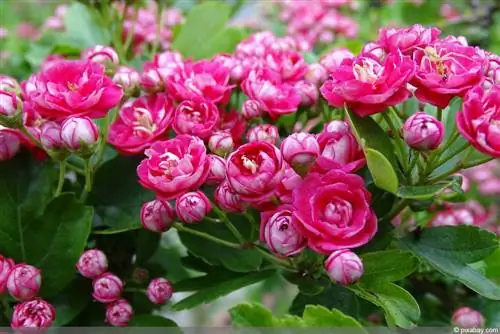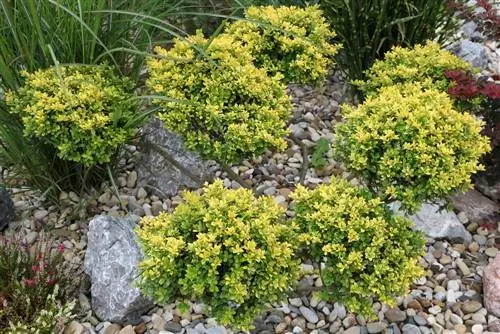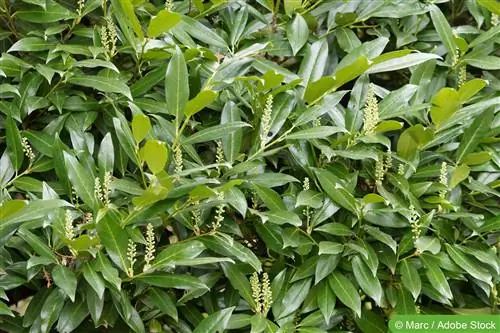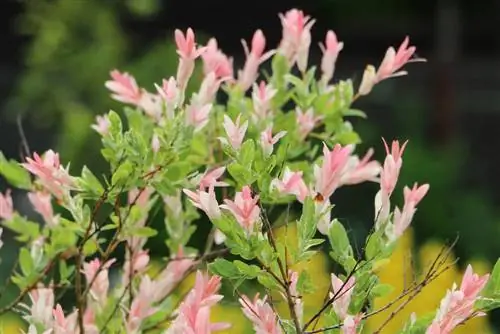- Author admin [email protected].
- Public 2023-12-17 03:39.
- Last modified 2025-01-24 12:45.
As it grows, the foliage can acquire a golden yellow hue, but can also develop into yellow-green or juicy green. With its high and upright growth, as well as its insensitivity to external influences, it is ideal for the garden and enchants with its unique golden charisma.
Planting a Golden Elm
The plant is available in garden stores as a small to medium-sized seedling. Before planting in the garden, the hole dug at the site is enriched with potting soil and possibly supplied with additional nutrients. The plant itself is placed in a container with water for about ten minutes. This allows the roots to absorb enough water before planting. This promotes rooting. You can tell that the plant has absorbed enough water by the fact that bubbles no longer appear in the container with water. The planting hole should be twice as large as the root ball and thus provide enough space for the golden elm to root. The gardener should then:
- fill the planting hole with nutrient-rich soil
- water the golden elm
- and check and water regularly in the beginning.
The location should not be chosen too sunny, as the sensitive leaves of the golden elm can easily burn and dry out in high heat. The plant thrives best in a partially shaded location and requires little maintenance. An exclusively shady place is unsuitable.
The correct care of the golden elm
A nutrient-rich and moist soil is preferred. Since the golden elm prefers calcareous and loose soil, the soil should be loosened before planting. Not every garden has the optimal conditions for attractive plant growth. By loosening the soil and adding gravel or sand, as well as adding lime, the growth conditions can be optimized and the basis for the habitat of the golden elm can be created.
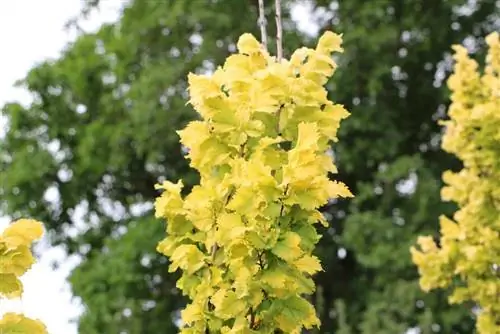
Caring for the golden elm does not require a lot of effort. Planted in the appropriate soil, this elm will easily support itself and draw the nutrients it needs directly from the soil. Fertilization should be carried out in spring to make the garden soil nutrient-rich again. Care includes fertilization in spring and any pruning to achieve the desired growth habit. With the right care, typical elm diseases can be avoided, which makes the golden elm a very resilient elm species.
Cutting and thinning
The plant can, but does not have to, be cut. In order to promote optimal growth or to give the golden elm the desired shape, pruning or thinning can be advantageous. Dry branches should not be cut off without checking the tree. They can indicate diseases and ensure that the other branches continue to dry after pruning. Since the golden elm is very popular even in small gardens and is often used to separate or fence off properties, it is recommended to cut it to the desired shape and height. In an optimally chosen location, the roots may form runners and show new shoots at some distance from the trunk. Here a simple cut is not enough, the gardener should:
- cut the additional shoots,
- digging up the roots,
- Avoid damaging the main roots when removing runners.
The best time for a trim is February. On a frost-free day, the golden elm can be cut into the desired shape and removed from the roots. Pruning must be carried out by mid-March at the latest so that the golden elm can sprout in spring and is not disturbed by pruning.
Diseases and their avoidance
The elm is known for various diseases. Although the golden elm is less susceptible to diseases that cause Dutch elm disease, it is not resistant to fungi and pest infestation. Dry branches and leaves drying out very quickly should be seen as a serious sign. Small holes in the trunk and spider web-like layers on the foliage also indicate a pest infestation and therefore a disease of the plant. The biggest threat to the golden elm is the elm bark beetle. This ensures feeding passages in the trunk and branches, which promotes the formation of fungi and limits the necessary absorption of water. Regularly checking for dry spots can prevent the tree from dying. If the elm tree is diseased, only quick action can save it. To do this you must:
- all dry branches and small twigs removed,
- Treated with a special oil for parasite infestation,
- as well as an extensive inspection of the entire plant.
The golden elm is considered a less susceptible member of the genus, but it is not spared from pest infestation. If the trunk or an entire tree is affected, the only way to prevent the disease from spreading is to fell the affected tree. When pruning the diseased branches, success will only be seen next spring. In contrast to cutting the golden elm into shape, the pruning of diseased parts of the plant must be done immediately and not in February. The longer the gardener waits to treat the tree, the higher the risk of complete infestation of the plant and thus the need to cut down the tree.
Thickenings on the leaves can indicate gall mites. In the event of a severe infestation, these small arachnids can be controlled with a product based on rapeseed oil or paraffin. An elm gall aphid can also attack the tree. It lives on pear trees in summer and overwinters on elm trees. The same remedies as against gall mites help here.
Sick golden elms can infect the entire tree population in the garden and ensure that he althy elms also become infected with the pests and a fungus and also show symptoms promptly.
What you should know about the golden elm in brief
- The golden elm needs nutrient-rich, moist and calcareous soil.
- So that it can root well after planting, the soil should be loosened beforehand.
- Clay soils can be made more permeable by adding a little sand or gravel.
In order to provide the new tree with enough nutrients, some compost or potting soil can be added to the planting hole as a substrate, so that the tree can easily supply itself with the necessary nutrients, especially in the beginning. Before planting, the root ball should be placed in a container with water for about ten minutes so that the roots can absorb enough water. This is the case when no more air bubbles rise from the water.
- Then the plant can be placed in the planting hole, which should be about twice as big as the ball.
- The remaining area is filled in with some garden soil.
- Immediately afterwards, there is plenty of watering and the new tree also needs to be supplied with water regularly in the following weeks.
- Fertilization should be carried out every spring; commercial garden fertilizer or natural fertilizers can be used.
If necessary, the crown of the golden elm can be thinned out where shoots are very close. Shoots that grow into the crown should be removed first. If the tree becomes too large overall, the side shoots can also be shortened accordingly. Pruning is best done between November and March, as no fragrances are released from the cut surfaces that attract the elm bark beetle, which is dangerous to the trees.

